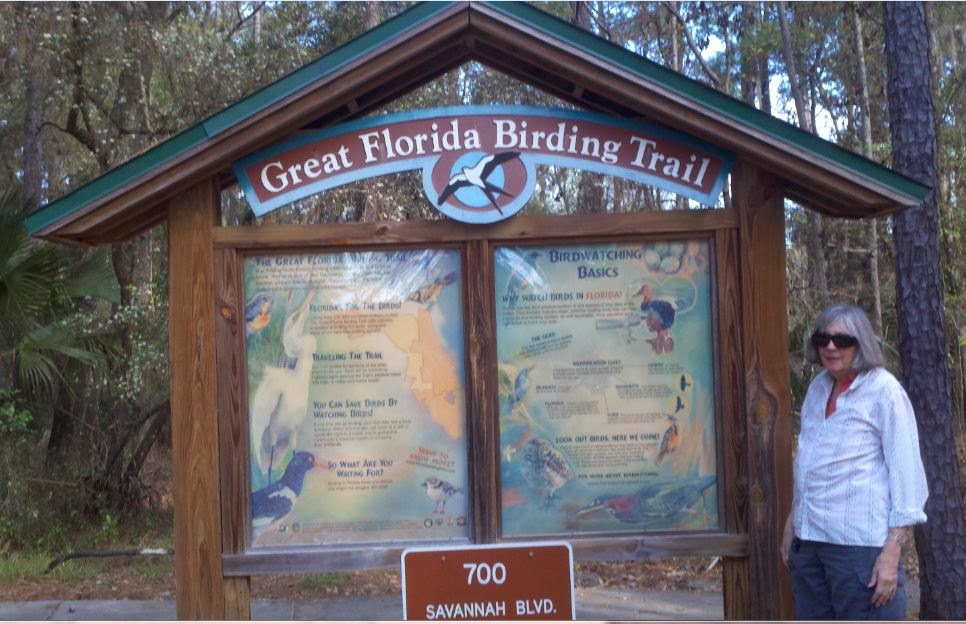We can’t believe our good fortune to be basking in the Florida Gulf Coast sunshine while all our friends back home are dealing with snow, frozen pipes and worries about their gardens. We’ve discovered that Florida is not immune to extreme weather however. The day before yesterday we had to pull over and wait out thunder, lightning and torrential rain. Here in Florida we are celebrating Severe Weather Awareness Week February 24 to 28. January was the wettest month on record here, with the rain closing schools, roads, business and local government due to severe flooding. Happily, we’ve managed to skip through the puddles pretty well and Lilypad dries off quickly given a little sun.
 |
| Many birds watched and trails trod, as well. |
We just left Tallahassee where we managed to take in the latest Meryl Streep movie, Costco, the farmer’s market and the Florida State History Museum all within 24 hours. We wistfully passed by Trader Joe’s and parked overnight with other RVers at Wal-Mart. There was some excitement when at 5am some over-zealous dog-loving police officer pounded on the door wanting to know if the stray service dog in the parking lot was ours. Those of you familiar with Janna’s attitudes towards dogs can just imagine the conversation after that encounter.
 |
| Our route, so far. Next we'll go to Selma, Asheville, and DC |
So what else have we been doing? We just passed 10,000 miles on our trip and soon will mark off five months of travel. We’ve visited 18 states, dallying less than a day in Texas and enjoying almost three months in Florida. We’ve spent about $3,900 on gas, $2,000 on campgrounds and $1,000 on admissions to 62 museums and historical sites. We’ve slept in 27 private campgrounds, 30 public campgrounds, six friends’ driveways, and in the parking lots of 13 businesses including one ferry terminal. We’ve travelled twenty National Scenic Byways and countless state ones and a few roads that should be scenic byways. We’ve soaked in four hot springs, seen two aquariums, and taken twelve boat trips. We’ve enjoyed many small towns, many of which beg for a return trip and more time. We’ve also driven through some great cities that felt welcoming with all the things we value: farmer’s markets, free public transportation, independent bookstores, free Wi-Fi, diverse demographics, public art and cultural events, good museums and tasty local organic food.
We’ve also come to the conclusion that the best way to appreciate
a place is not necessarily through a stop at the visitor information center,
but rather, the local history museum. Especially in small places these
collections capture the sense of place through time that no array of current
services or businesses can convey. Often they exhibit artifacts or remnants of
human or natural history that can no longer be seen on the current landscape,
but unquestionably deepen the significance of the place. We find it amazing
that places can be vastly different, towns can cease to exist, something
monumental might have happened here long ago; and we would never have known, had we not
stopped at the local museum. And of course these museums provide an opportunity
to connect with enthusiastic local residents who treasure their area and the
elements that make that place unique. Those encounters with folks that love a
place, both strangers and friends, have made up some of our most precious
memories of this trip.
Another important part of this trip has been the many visits
to actual historical sites. Reading about what happened is one thing but
finding yourself at Shiloh or Jamestown or Kittyhawk or Monticello or Yarnell or the Charleston Slave Mart is
quite another. Even if there is nothing left but an historical marker along the
side of the road, we found it quite moving to be right here in this place where
it actually happened. We have learned to stop for historical markers. You never
know what you might find. One such place was Rosewood Florida. If you don’t
know about Rosewood, read the historical marker in the attached picture or check it out in Wikipedia.This we know: these places matter.








